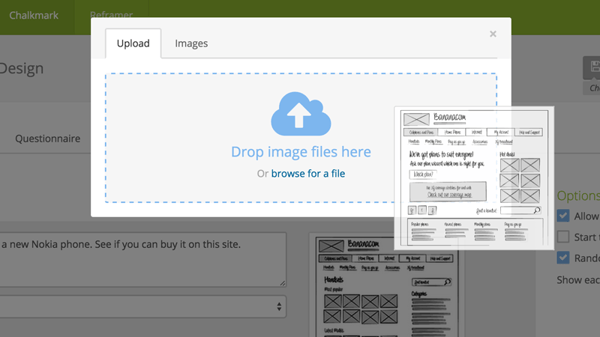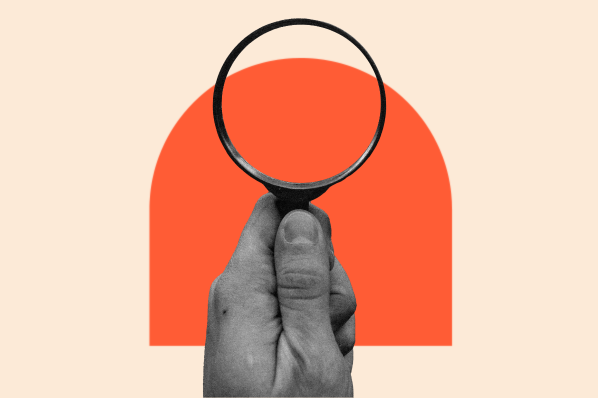Picture your favorite website or app. Now, think about why it's your favorite. Is it because of how it looks, or because of what it does? Probably a little bit of both, right? That's because effective designs, like your favorite website's, play a crucial role in achieving customer success.

Whenever a customer visits your website or downloads your software, they have a goal that they're striving to meet. However, even if your product is exactly what they're looking for, they'll quickly turn to competitors if they can't navigate your interface. Customers have high expectations, making it essential to invest in a user-friendly design for your website, app, or software. But, how do you tell the difference between a good and bad design?
First click testing is a great way to make this distinction because it allows you to target a specific aspect of your product for testing. In this post, we'll cover the benefits of first click testing as well as provide the steps needed to set up your own click test.
First Click Testing
First click testing provides unbiased insight into how user-friendly a website, app, or software is. The test asks participants to complete a task and then measures how easy it was for them to do so. Depending on the user's actions, the experiment will prove if a feature on a website or software is easy to find and use. By gathering this first party data, companies can measure the effectiveness of their designs in simulated scenarios.
First click testing differs from product surveys because it determines what a user was trying to achieve and where exactly they got stuck. Customer reviews can sometimes be repetitive, as people often report the same obvious problems that design teams are already aware of. Instead, first click testing allows engineers to ask questions about a certain aspect of their design that are getting overlooked.
Why Do First Click Testing
Customer Success
When you help customers achieve their goals, they're more likely to buy from you again. By conducting first click tests, you can optimize your interface for customer success. A study conducted by Bob Bailey and Cari Wolfson, revealed that if a user's first click is correct, they have an 87% chance of completing the action. If the click was wrong, less than half were able to complete the task. This means that if your design is user-friendly, then customers will have a better chance of achieving their goals.
Reusable Testing
One of the best features of first click testing is that the same test can be reused throughout the development process. Design teams can continuously test changes throughout every stage of development until the product is perfect. Rather than taking chances, first click testing provides developers with concrete data that indicates whether a new feature or product will be successful.
Informed Decision-Making
When a participant is asked to complete a task, first click testing also measures how long it to record a click. The time that it takes to perform the action can then be compared to your design alternatives. Engineers can test which interface yields the fastest completion and then implement a customer-centric change. This approach keeps design teams focused on customer needs because they have clear insight into how users are interacting with their product.
How to Create a First Click Test
1. Present a task.
The first step in creating a first click test is to present the user with a task. Be sure to give them the task prior to seeing the interface so that you can measure reaction time. When determining a task, use your customer journey map to identify different customer roadblocks. Then, think about the customer's goals in those scenarios and look for areas of your design that could impede them. Be broad, and present a simple, but relatable objective. For example, a good task could be, "Please click where you add a product to a shopping cart." Or, like in the one in the example below.

2. Display the interface.
Once the task is clear to the participant, the next step is to show them your website, app or software. When conducting your first click test, the interface doesn't have to be too advanced. Depending on where you're in the development process, it can be a product screenshot, a prototype, or even a detailed sketch. As you continue building the product, you can always swap out the interface for a more updated version.
If you run into roadblocks at this step, you can adopt software that simulates your product using screenshots and prototypes. These tools automatically create clickmaps that indicate exactly where clicks are taking place on your interface. This can save your developers time and provide unique insights that may not be clear in a manual test. We'll provide some examples of these programs later in this post.
3. Record user behavior.
As soon as the interface is displayed, begin recording the participant's actions. First click testing measures two key metrics: Where the user clicked and how long it took for them to click. These two metrics indicate if the task was achievable as well as how difficult it was to complete it. After repeating the test on all participants, we can analyze these two factors to determine the usability of a specific product or feature.
4. Ask for feedback.
While gathering quantitative data is great, this is also a perfect opportunity to obtain user feedback as well. After testing, survey your participants to gain deeper insight into why they behaved the way that they did. If they clicked in an unanticipated spot, ask them why they chose that area. For users who took more time to click than others, find out if there were any obvious roadblocks that distracted their focus. Considering adopting a system usability scale as that surveys users on how difficult they felt there experience with the product was.
5. Analyze your results.
When analyzing your results begin with the percentage of people who were unable to complete the task. If the percentage seems high, look at clickmaps or heatmaps to determine where they clicked and compare it to their reasoning for it. Consider the demographics of these users and come up with potential changes that could appease this segment of your target audience.
For the users who completed the task, the next step is to investigate how long it took for them to do so. The goal is to have this timing be as fast as possible because the less time it takes, the more user-friendly your design is. One way to approach this is to have an employee perform the task, then see if users can complete it at the same rate. If both a product expert and a beginner can perform the task in the same amount of time, then the feature is easy to use.
Looking to save some time by automating this test? Check out the section below for first click testing software that you can implement in your product development process.
First Click Testing Software
UsabilityHub
Usability Hub is an in-depth first click testing tool that shows designers more than just where a customer clicked. It provides click cluster maps that display customer answers to follow up questions when you hover over a cluster. They also offer a funnel visualization tool that highlights where users are dropping off most frequently on your live interface.
Price: Starts free, up to $398 per month
 Source: UsabilityHub
Source: UsabilityHub
Optimal Workshop
Optimal Workshop has a "Chalkmark" tool that helps companies measure the first impressions of their designs. The tool provides quick feedback on interface layouts and makes it easy to create first click tests. When using the Optimal Workshop tool, you only need to decide on the task to test, then the program creates the test for you. This saves your team valuable time and allows you to measure more features during development.
Price: Starts free, up to $166 per month

Source: Optimal Workshop
UserZoom
User Zoom is a product testing tool that lets you define multiple parameters during testing. Those parameters are then compounded into one report that displays a range of metrics on your click test. This allows you to measure one scenario for a variety of different metrics other than just click placement and timing.
Price: Variable
 Source: UserZoom
Source: UserZoomHubSpot
HubSpot offers unique content staging and preview tools that simulate a live version of your website or email. With HubSpot, you can run A/B tests on your web pages and emails to determine which designs perform better on your target audience. If you're looking to test out a specific feature, you can also use HubSpot's clickmap tools to run manual first click tests.
Price: Starts free, up to $3,200 per month
 Source: HubSpot
Source: HubSpotLooking for more ways to survey customers on your website or app's design? Learn how a system usability scale can gather user experience data in this next post.






![5 Qualitative Research Methods Every UX Researcher Should Know [+ Examples]](https://www.hubspot.com/hubfs/qualitative%20reseach%20methods_featured.png)
![How the Serial Position Effect Influences Your Users [Cheat Sheet]](https://www.hubspot.com/hubfs/shoppers%20making%20purchasing%20decisions%20off%20of%20the%20serial%20position%20effect.jpg)



